Dill grows to about 2 feet tall and has fine, feathery leaves. Dill is an annual herb used as an herb or spice. The leaves are delicate and have a sweet, tangy flavor. Dill is relatively easy to grow from seed. Dill is a short-lived plant and will not last more than one season. This means you need to sow Dill seeds yearly if you want a continuous supply of fresh leaves.

How to grow Dill from seed to harvest
How long does Dill take from seed to harvest?
- Unless Dill is harvested and used promptly, the crop may bolt, which means it flowers prematurely or goes to seed. Dill is a hardy and fast-growing herb, thanks to its hearty nature. This plant needs average soil, plenty of sunlight, and moderate moisture.
- Planting Dill seeds will take 10 to 14 days for the plants to begin sprouting. Lower temperatures will slow this process, so be sure the soil is warmer than 15°C before planting your Dill seeds. Expect to harvest your Dill in 6 to 8 weeks, depending on your growing conditions.
- Dill flowers bloom about two weeks after their yellow umbels appear, usually around 70 days after planting. Healthy Dill plants will continue to produce for four or more weeks. Dill grows rapidly, but it takes about 4 to 8 weeks to mature enough for harvesting. You can start harvesting the plant when your Dill plant has at least four or five leaves. Just be careful to remove only a third of the plant at a time.
Harvesting of Dill
- To harvest Dill seeds, wait until the seed heads are fully ripe and brown. The best way to harvest them is by clipping the clusters of seeds into a paper bag. Let the bag sit where it’s dry and warm indoors for a week or more, then shake the bag to see if any seeds have shaken loose.
- To harvest Dill, cut the plant to 2 to 3 inches above the ground when the leaves are full and green. You can then dry the leaves or use them fresh. If you are using them fresh, cut the leaves off the stem.
In case you missed it: How to Grow Sage from Seed to Harvest: Planting and Care
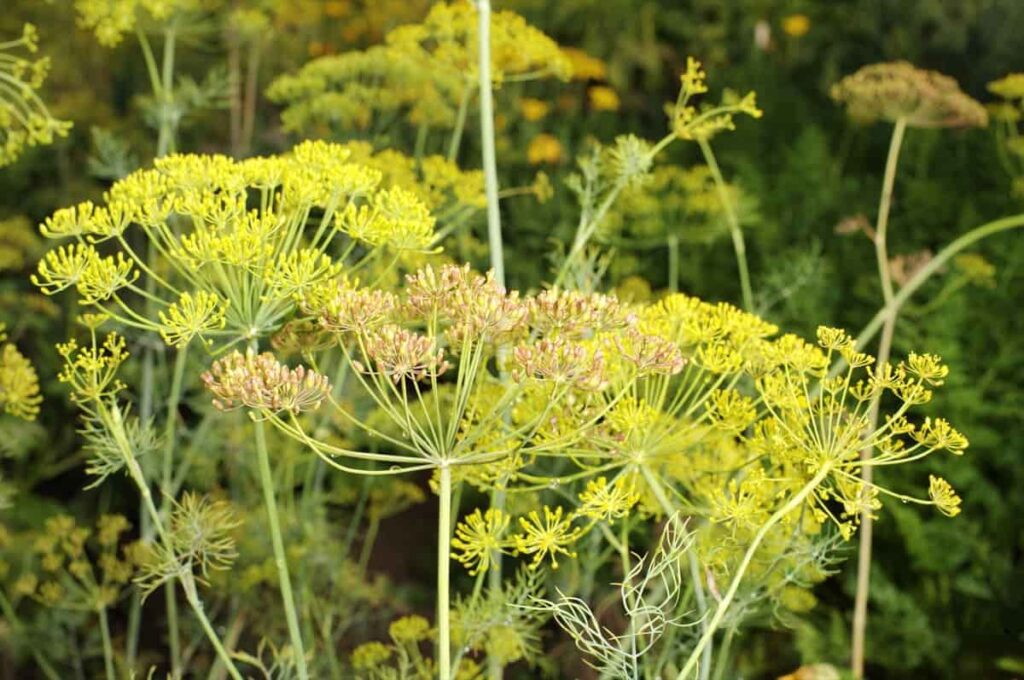
Can Dill be grown from seeds?
- Dill is an easy herb to grow, even with little prior experience. All you need is a spot in your garden that’s sunny and gets plenty of sunlight. Dill grows best when the soil temperature is between 15°C to 20°C. If it gets hot, it will bolt (grow too tall and produce yellow flowers).
- Dill does not transplant easily. Plant the Dill seeds directly in the ground where they’re going to grow. Begin sowing seeds after the danger of spring frost has passed. You can harvest several crops during the summer and fall by planting seeds every two to three weeks through midsummer.
Sun requirement for growing Dill
- Dill is an easy-to-grow herb that should be planted in the ground. If you have heavy clay soil that holds water, it’s helpful to add organic matter, such as compost, to the top few inches of soil to help drainage. Dill requires at least six hours of direct sunlight daily, so plant it in a location that receives this amount. The tall, hollow stalks can blow over easily if not staked down, so be sure your chosen spot is protected from winds. Dill does not transplant easily, so sow the Dill seeds directly into the soil where they will grow.
- Plant the seeds in pots or your garden bed, keeping them moist but not soggy. Once the seedlings appear, thin them out, so they are about 6 inches apart. Dill loves full sun, so make sure to give it plenty of light throughout the day. Water regularly, especially during hot weather, and fertilize every few weeks with an all-purpose fertilizer. You can begin harvesting Dill leaves once they reach about 6 inches in length.
Water requirement for growing Dill
- To grow Dill, you’ll need to water it properly. Keep the soil evenly moist during seed germination and plant growth. Once plants start growing, about 1 to 2 inches of rain or additional water is needed for them to thrive. Most herbs, including Dill, don’t need additional fertilizer. Dill likes to be watered moderately. Unlike other plants, Dill does not generally need periods of dryness between waterings.
- You should water your Dill every week, but not more often than once a week. The soil should be moist to a depth of 6 inches. A dry surface at 2 inches is a clear sign that your plant needs watering.
- Water your Dill weekly and ensure the soil is moist at 6 inches. You’ll know your Dill needs more water when the soil is dry at 1 inch. If the leaves start to wilt, that’s a sign that the plant needs more water. To keep your Dill plants healthy and hydrated, you should use a watering can to give them a good drink every week. If your area has frequent rainfall, you may need to water less often. Check the soil before watering to see if it’s dry or the plants need a drink.
In case you missed it: 16 Fragrant Spring-flowering Shrubs: How to Grow, Planting, and Care
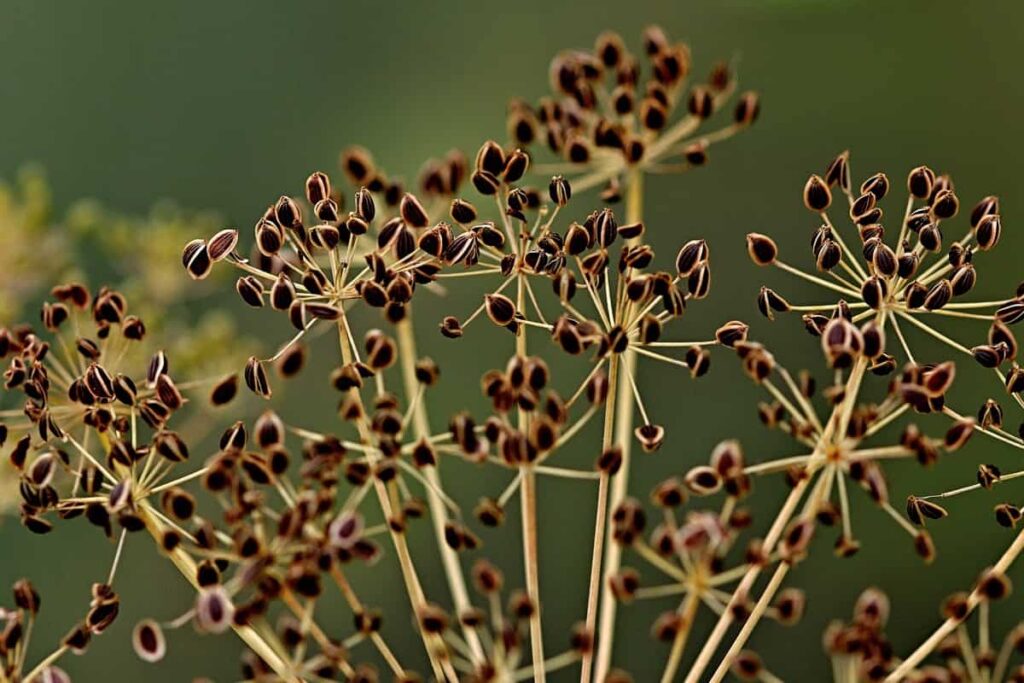
What should I plant next to the Dill?
The Dill herb is a great companion for Corn, Cucumbers, Lettuce, and Onion plantings. Avoid planting near Carrots and Tomatoes. Dill goes well with other plants, including Cabbage, Potatoes, Radishes, and Onions. When growing Dill in your garden, consider planting it next to one of these other vegetables for the best results.
Dill care in winter
Dill is a hardy annual herb that can withstand cold winters. It can be grown in containers and overwintered indoors or direct seeded in the fall for a spring harvest. Dill does best in full sun but will tolerate some shade. The soil should be well-drained and rich in organic matter. Keep the soil moist but not wet.
Pruning overgrown Dill
- Never trim more than a third of the plant, and always leave enough time for the plant to recover before trimming again. Doing this will make sure that your Dill can regrow. Dill can be trimmed anytime it’s green and growing.
- Prune the leaves from the top, encouraging new growth outwards instead of up. Leave at least two-thirds of the Dill when trimming it so it doesn’t die. To prune Dill, pinching the growing tips to encourage a bushier plant. More stems and leaves mean more availability to harvest Dill.
Best time to harvest Dill
Dill leaves can be picked any time before the plants start to flower. However, if you want an optimal harvest, it’s best to pick them just before they flower. That’s when the oil in the leaves is strongest and has a better flavor. If you don’t want your Dill herb to go to seed, keep it from flowering by pulling any flowers that appear and sowing new seeds in their place.
Does Dill have deep roots?
- Make sure you use a container at least 10 inches deep. The pot should be placed in an area that receives 6 to 8 hours of sunlight daily and where Dill can reach its full growth potential.
- The plant is an annual herb that can grow two to three feet tall. Dill has fine, feathery leaves that are green in color. The plant flowers in the summer and produces small, brown seeds. Dill grows best in full sun and fertile, well-drained soil. The plant is relatively easy to care for and does not require much attention. Dill will self-seed if left unchecked, so it is best to deadhead the flowers to prevent unwanted seedlings.
In case you missed it: How to Grow Love-in-a-mist in Your Backyard: At Home, Soil, Propagation, Planting, and Care
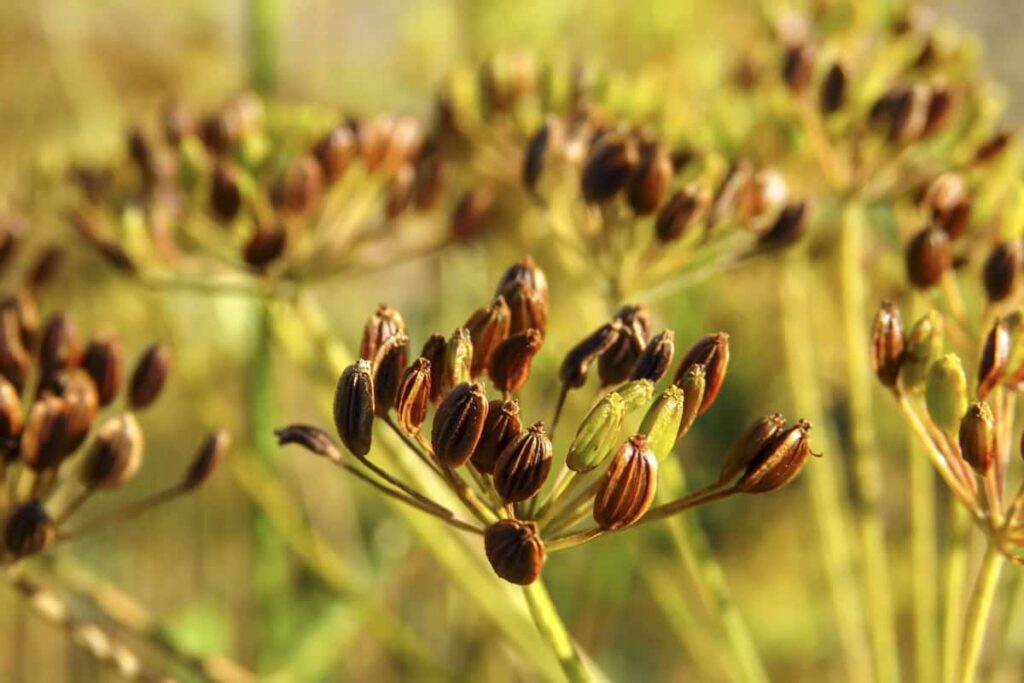
Best time to plant Dill
- Dill can be grown indoors or outside from early spring or directly outside from May to July. To grow Dill indoors, use individual cell trays or plant a few seeds per pot. When it’s time to take out your Dill plants, harden them off for one to two weeks before transplanting if they were originally planted inside.
- In colder climates, it is best to plant Dill in the spring so that it has a chance to establish itself before the first frost. Dills can be planted in the fall and overwinter in warmer climates. Dill does not like hot weather, so in hot climates, it is best to plant Dill in the fall or winter so that it does not bolt.
Planting Dill seeds
- Dill seeds need to be exposed to light to germinate. To plant the seeds, sow them no more than six inches apart in rows eighteen inches apart. Once they’re planted, thin them, so they are at least six inches apart.
- Dill seeds can be planted at different depths, depending on the size of the seed. For example, smaller seeds can be planted shallowly, while larger seeds should be planted deeper. The depth of the planting hole also depends on the soil you use. The planting hole should be shallower if you use light or sandy soil. The planting hole should be deeper if you use heavy or clay soil.
- When deciding how deep to plant your Dill seeds, it is essential to consider the amount of rainfall in your area. If your area has high rainfall, you need to plant your seeds deeper, so they do not get washed away.
Should I deadhead Dill?
- As soon as buds grow on Dill plants, removing them immediately is best. This will encourage the plant to sprout more leaves lower on its stalk and discourage it from growing taller. Plucking off buds and pruning upper leaves will help your Dill plants become bushy instead of tall and thin.
- For Dill, deadheading is not necessary. Letting the plant go to seed can be beneficial. Dill seeds are often used in cooking, so if you allow your plant to produce them, you’ll have a ready supply. Additionally, Dill plants self-seed readily, so allowing them to set seeds can help ensure a continuous crop.
Why does my Dill plant keep falling over?
- Perhaps your seedlings are experiencing some issues. Legginess and damping off are two common conditions that can lead to your plant falling over. Leggy seedlings grow tall and spindly when they don’t have enough light, while damping off is a disease that affects seedlings when they’re just beginning to sprout.
- Dill plants have large, umbrella-like leaves that can make them top-heavy and prone to toppling over in windy conditions or when they are heavy with seed heads. Another possibility is that the plant needs more support. If the plant’s roots are not firmly anchored in the ground, the plant will be more likely to fall over. This can be caused by too much water or fertilizer, which can make the soil loose and unable to support the plant.
- If you suspect that your Dill plant is toppling over due to one of these reasons, you can do a few things to remedy the situation. For example, try staking your Dill plant so that it has extra support. You can also try trimming back the leaves to help reduce the top-heaviness of the plant. With some care and attention, you can keep your Dill plant upright and healthy all season long.
In case you missed it: How to Grow Mosambi in Pots: At Home, Soil, Propagation, Planting, and Care
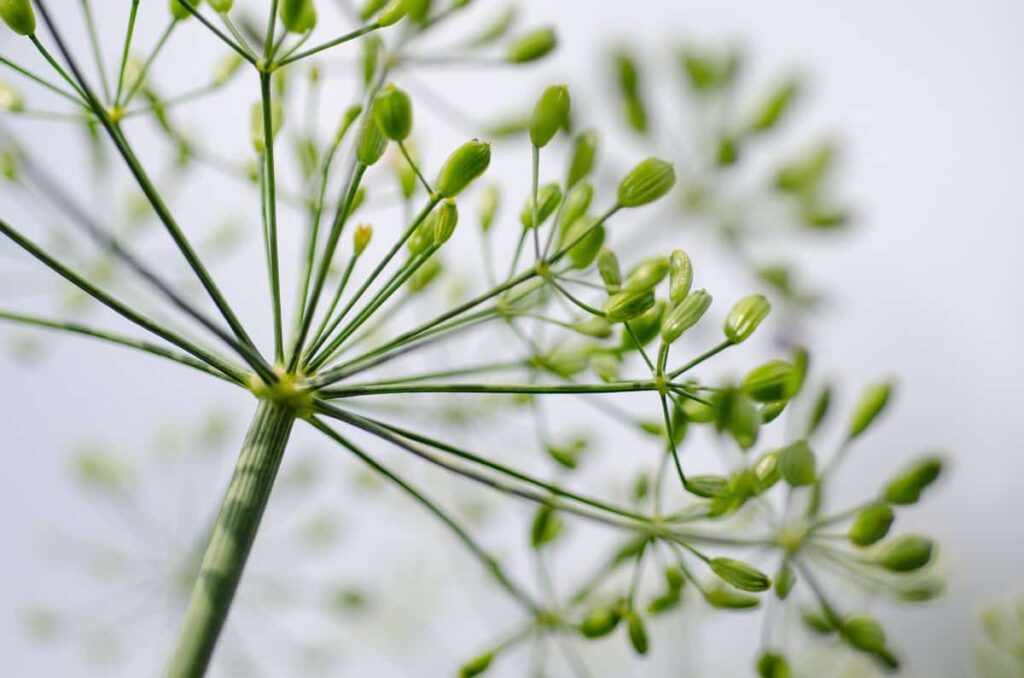
est fertilizer for growing Dill
- Dill thrives well in well-drained and slightly acidic soil rich in organic matter. As with most herbs, Dill does not require frequent fertilizing. A light feeding of a 5-10-5 fertilizer applied once in late spring should be enough.
- Dill grows best in full sun and rich, well-drained soil. It is a hardy annual that will self-seed if left to flower. Dill does not require much fertilizer but benefits from being fertilized every few weeks during the growing season. The best fertilizer for Dill is a balanced 10-10-10 fertilizer or a water-soluble 20-20-20 fertilizer.
Soil requirement for growing Dill
- You’ll need to start with good-quality soil to grow Dill from seed. Dill loves well-drained soils that are high in organic matter. You can add compost or other organic matter if the soil is deficient. You can add some sand to improve drainage.
- Once your soil is prepared, you’ll need to sow the seeds. Dill seeds are very small, so it’s best to mix them with sand before sowing. This will help to distribute them more evenly. Sow the seeds on the soil’s surface and lightly press them down. Water the area gently so as not to disturb the seeds.
Growing Dill in pots
- It is a fast-growing herb for growing Dill in pots, so you must replant it every few weeks to keep a steady supply. Dill does best in full sun, so make sure your pot has good drainage and is in a sunny spot.
- To plant Dill in a pot, fill the pot with well-draining soil. Then, sow the Dill seeds about 1/2 inch deep and water them well. Once the seedlings emerge, thin them out, so they are about 6 inches apart. Dill plants can get pretty big, so choose a large pot to accommodate their growth.
- Water your Dill plants regularly, especially during dry periods. To harvest the leaves, cut them off at the stem above where they branch. You can also harvest the seeds by letting the flower heads dry on the plant and then breaking them open to release the seeds.
In case you missed it: 42 Key Rules for Container Gardening: From Planning to Reducing Production Cost
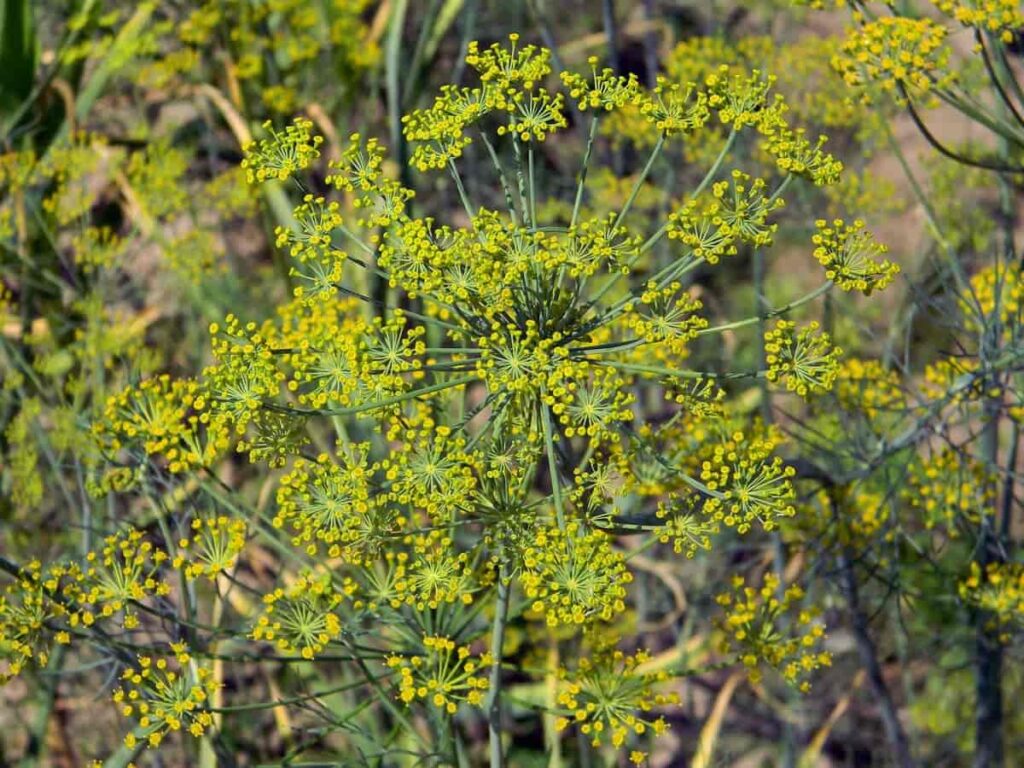
Germinating Dill seeds indoors
- To grow Dill from seed, you should soak the seeds in water for 24 hours. This will help them germinate faster. Plant the seeds in soil mixed with organic matter, such as compost. Sow the seeds thinly, as they need room to grow.
- If growing Dill indoors, you’ll need to start the seeds in pots or trays filled with soil. Sow the seeds about 1/4 inch deep and keep the soil moist. Germination can take up to two weeks, so be patient.
- Water the soil lightly and keep it moist. The Dill seeds should germinate within 10 to 14 days. Once the seedlings emerge, thin them out, so they’re spaced about 6 inches apart. Keep watering them regularly and fertilize them every few weeks. When the plants are big enough, transplant them into individual pots or outdoor garden beds.
Conclusion
Growing Dill from seed is a simple process that anyone with patience can accomplish. With just a few supplies and basic knowledge, you can have fresh Dill to use in your cooking all season long.
- Flower Garden Designs and Layouts for Beginners
- Planting and Spacing Techniques in Papaya: A Beginner’s Guide
- Growing Gold: Essential Techniques for Planting Pineapples
- How to Make Kalanchoe Plant Bushy: Home Remedies and Solutions
- 11 Reasons Why Your Gardenia is Not Blooming: Home Remedies and Solutions
- Eco Elegance: The Guide to Designing a Drought-Tolerant Landscape
- Gardening on a Slope: Strategies for Hillside Landscaping
- Nourish and Flourish: Top Organic Mulches for Thriving House Plants
- Everything You Want to Know about Indian Mogra Flower: Discover Uses and Growing
- Green Thumb Success: Expert Tips for Cultivating Greenhouse Pumpkins All Year Round
- Maximize Growth & Flavor: The Ultimate Guide to Companion Planting in Herb Gardens
- How to Control Rhododendron Problems Naturally: Home Remedies and Organic Ways to Fix Them
- Natural Magic: The Remarkable Benefits of Cinnamon for Plants
- Best Steps to Revive Dying Tulip with Natural and Organic Treatment
- 10 Reasons Why Your Angel Trumpet is Not Blooming: Remedies and Treatment
- How to Fix Periwinkle Leaf and Flower-Related Problems: Natural Remedies and Solutions
- How to Fix Zinnias Leaf and Flower Problems: Discover Natural and Home Remedies
- Organic Steps to Induce Lemon Tree Flowers: A Comprehensive Guide
- Bloom Booster: Crafting the Perfect Homemade Bougainvillea Fertilizer
- Optimizing Growth: A Guide to Applying NPK Fertilizer for Potted Plants
- 10 Best Homemade Fertilizers for Rubber Plant: DIY Recipes and Application Method
- How to Boost Female Pumpkin Flowers: Effective Steps for More Flowers and High Yields
- Transform Your Indoor Garden: Top Benefits of Pink Salt for Houseplants
- 10 Best Homemade Fertilizers for Peacock Plants (Calathea): Easy DIY Guide
- Unlock Blooms: 9 Reasons Why Your Potted Chrysanthemum is Not Blooming
- 8 Reasons Why Your Potted Hibiscus is Not Blooming: Fix it with Simple Solutions
- Unlock Blooms: 9 Key Reasons Your Potted Frangipani Won’t Flower
- 10 Reasons Why Is My Ice Plant Not Blooming: Remedies and Treatment
- 10 Reasons Why My Potted Hydrangea Not Blooming: Treatment and Remedies
- 10 Reasons Why is My Wisteria Not Blooming: Remedies and Treatment
- 10 Reasons Why is My Goldfish Plant Not Blooming: Remedies and Treatment
- Maximize Your Space: Ultimate Guide to Balcony Gardening with Grow Bags
- 10 Reasons Why Your Iris is Not Blooming: Remedies and Treatment
- 10 Reasons Why Your Anthurium Plant is Not Blooming: Treatment and Remedies
- 10 Reasons Why Your Aquaponic Plants Are Not Flowering: Remedies and Treatment
- 10 Reasons Why Your Agapanthus is Not Flowering: Remedies and Treatment